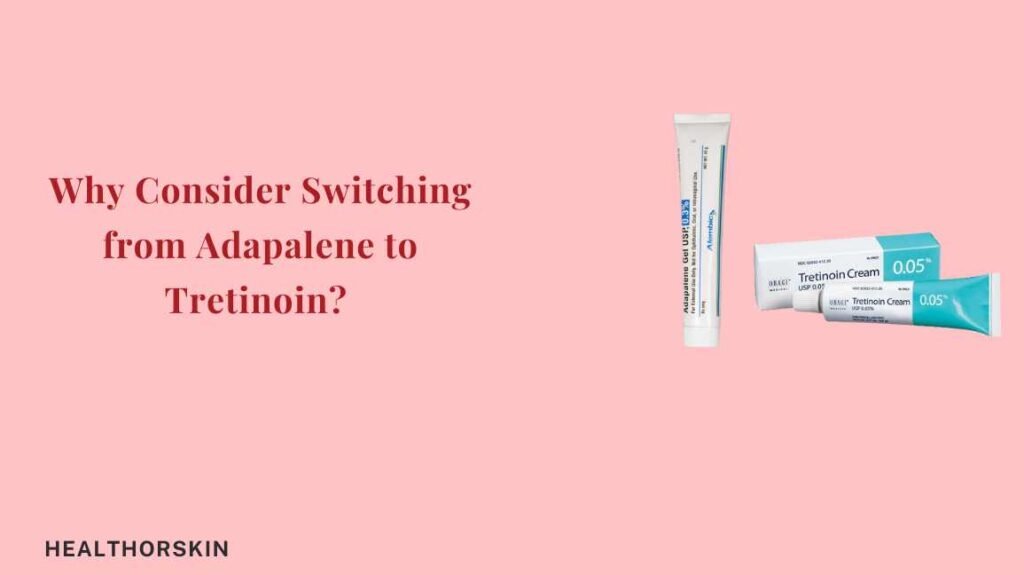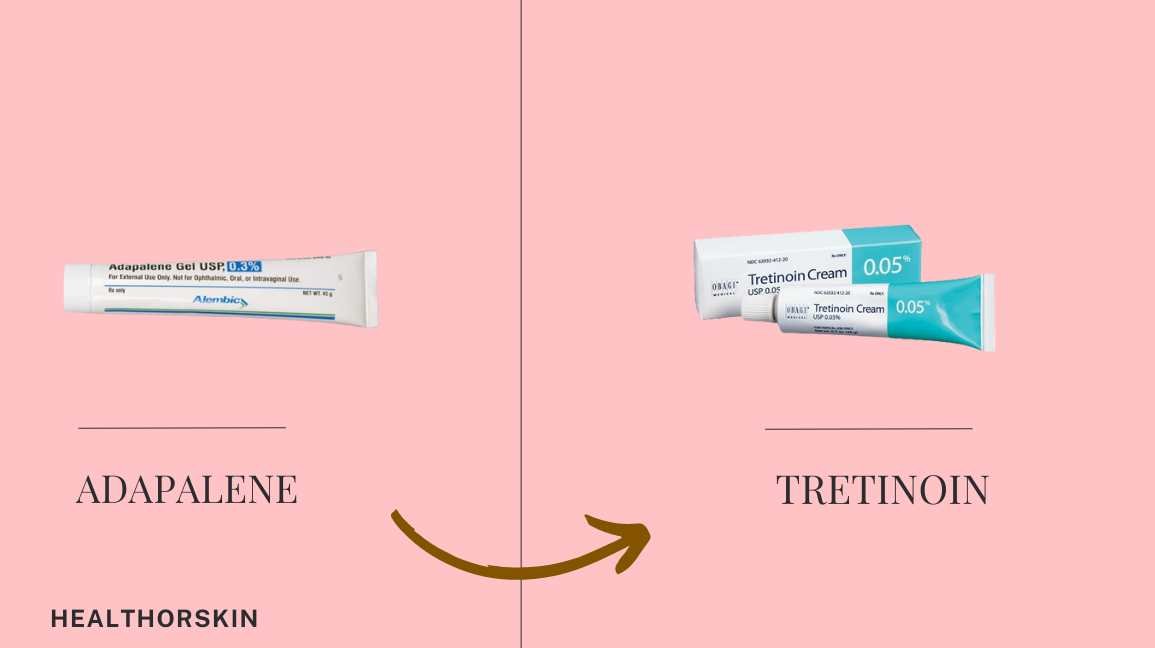Switching from one topical retinoid to another is common for those struggling with acne or other skin issues. Both Adapalene and Tretinoin belong to the class of drugs known as retinoids, renowned for their efficacy in treating acne and promoting skin renewal.
Adapalene and tretinoin are two popular options that belong to the class of drugs known as retinoids, but making the switch from one to the other can be confusing for some.
Both creams are highly effective in treating acne, though they may differ in their overall efficacy. If you have successfully managed breakouts with Adapalene, you might be wondering if there is a more advanced option available.
This article explores the reasons why someone might consider switching to tretinoin. We’ll break down the advantages of tretinoin, discuss potential side effects, and examine what science says about its effectiveness for acne.
What is Adapalene?
Adapalene, sold under brand names like Differin, is a cream or gel medication applied directly to the skin. It is a third-generation retinoid, which means it is chemically similar to vitamin A and works by affecting skin cell turnover.
However, doctors can also sometimes use it “off-label” (meaning for something the FDA hasn’t specifically approved) to treat other skin issues like psoriasis, discoloration (pigmentation disorders), rosacea, hair loss (alopecia areata), warts, and sun damage (photoaging).
Adapalene can help regulate the amount of oil your skin produces. Excess oil can mix with dead skin cells and clog pores, but Adapalene helps keep that in check too. In short, Adapalene can be a powerful tool in your fight against acne.
Specific Uses of Adapalene
Here’s a breakdown of its specific uses:
- Mild to Moderate Acne: Adapalene shines in treating comedonal acne, characterized by whiteheads (closed comedones) and blackheads (open comedones). It can also be effective for inflammatory acne with papules (small, red bumps) and pustules (pus-filled bumps).
- Maintenance Therapy: Once your acne is under control, adapalene can help prevent future breakouts by regulating cell turnover and keeping pores clear.
What is Tretinoin?
Tretinoin is a prescription retinoid medication available in various strengths and formulations (creams, gels, lotions) to target a wide range of skin concerns.
Tretinoin tackles acne and wrinkles in multiple ways. It speeds up skin cell turnover, keeping pores clear and wrinkles less noticeable. It also fights inflammation, reducing pimple redness and swelling. Tretinoin can help regulate oil production, preventing future breakouts.
Specific Uses of Tretinoin
Tretinoin’s impressive list of uses makes it a multi-tasking wonder drug for the skin:
- Acne Treatment: Tretinoin tackles all forms of acne, from comedones (whiteheads and blackheads) to inflammatory papules (red bumps) and pustules (pus-filled bumps). It unclogs pores, reduces inflammation, and promotes cell turnover to keep your skin breakout-free.
- Anti-Aging Champion: As we age, collagen production slows down, leading to wrinkles and fine lines. Tretinoin stimulates collagen production, plumps the skin, and minimizes the appearance of wrinkles, giving you a more youthful look.
- Sun Damage Savior: Sun exposure damages skin cells and contributes to hyperpigmentation (dark spots) and uneven skin tone. Tretinoin helps fade existing sun damage and even out skin tone for a brighter, more radiant complexion.
- Other Potential Uses: Tretinoin may also be used for certain precancerous skin lesions (actinic keratosis) under the guidance of a dermatologist.
Also Read: Does Winlevi Cause Skin Purging? Unveiling the Truth
Can you switch from Adapalene to Tretinoin?
Absolutely! In fact, switching from Adapalene to Tretinoin is a common progression for those who have achieved good results with Adapalene but desire a more potent treatment for persistent acne or wish to add anti-aging benefits into their routine.
While switching from Adapalene to Tretinoin can be beneficial, it’s important to remember that Tretinoin can be more irritating, especially during the initial adjustment period.
You might experience dryness, redness, or flaking. If these side effects become severe or persistent, consult your dermatologist for guidance.
Why Consider Switching from Adapalene to Tretinoin?

Switching from Adapalene to Tretinoin can be a strategic move for several reasons.
First, Tretinoin is a stronger retinoid, which makes it especially helpful for people with persistent or moderate to severe acne that hasn’t improved with Adapalene.
Secondly, Tretinoin offers robust anti-aging benefits; it excels at stimulating collagen production, which helps to reduce the appearance of fine lines and wrinkles. Its broader scope of efficacy includes addressing issues like hyperpigmentation, uneven skin tone, and even certain precancerous skin lesions.
The switch might cause some dryness, redness, or peeling at first but the long-term benefits usually make it worth it.
Related: Can Triamcinolone Acetonide Cream be used for dark spots or skin lightening?
Who Can Make the Switch?
Generally, anyone who has used Adapalene successfully and desires a more potent retinoid or anti-aging benefits can consider transitioning to Tretinoin.
However, a consultation with your dermatologist is crucial to ensure it’s the right choice for your specific skin concerns and sensitivity level.
How to Make the Switch Seamlessly?
Don’t suddenly stop using Adapalene and switch to Tretinoin. Here’s how to make a smooth change with help from a dermatologist:
1. Consultation is Key:
Schedule a detailed consultation with your dermatologist. Explain your desire to switch products and discuss your current skincare routine. They can assess your skin type, acne severity, and tolerance to adapalene for a personalized approach.
2. Start Low, Go Slow:
Tretinoin is usually more potent than adapalene. To minimize the risk of irritation, dryness, and peeling, your dermatologist will likely prescribe a low-strength formula to begin with (e.g., 0.025% tretinoin cream). You can gradually increase the strength as your skin adjusts, allowing for better acclimation.
3. Adjusting Your Routine:
Switching to tretinoin might necessitate modifying your skincare routine. Be mindful of potential interactions:
- Avoid harsh cleansers: Opt for gentle, fragrance-free cleansers to prevent stripping your skin’s natural oils, which can worsen dryness and irritation.
- Minimize other exfoliating products: Tretinoin already promotes cell turnover, so using additional exfoliating products (e.g., AHAs, BHAs) can be too harsh.
- Prioritize hydration: Moisturization is crucial. Look for fragrance-free moisturizers with hyaluronic acid or ceramides to help your skin retain moisture and maintain a healthy barrier.
- Discuss any medication interactions: Inform your dermatologist about any other topical medications you’re using to avoid potential interactions.
4. Sun Protection on High Alert:
Tretinoin significantly increases your skin’s sensitivity to sunlight. Consistent and diligent sunscreen use (SPF 30 or higher, broad spectrum) is absolutely essential during the transition and beyond. Apply sunscreen every day, even on cloudy days.
Potential Side Effects of Tretinoin Transition and How to Manage Them?
Switching from Adapalene to Tretinoin can be a powerful move for clearer, smoother skin. However, the transition phase might not be entirely smooth sailing. Here’s a detailed breakdown of what you might encounter and how to manage these temporary side effects for a smoother journey:
Temporary Irritation:
- Dryness: Tretinoin can disrupt your skin’s natural moisture barrier, leading to dryness, especially in the initial weeks. This can manifest as a feeling of tightness, flakiness, or a rough texture.
- Redness: Inflammation is a common response to introducing a new topical medication. Tretinoin can cause mild to moderate redness, particularly in sensitive areas like around the nose and mouth.
- Peeling: As Tretinoin accelerates cell turnover, it can lead to increased shedding of dead skin cells, resulting in visible peeling. This is usually a good sign, indicating the medication is working, but it can be aesthetically bothersome.
Managing Irritation:
- .Gentle Skincare Routine: Opt for fragrance-free, non-comedogenic cleansers and moisturizers. Look for ingredients like hyaluronic acid, ceramides, and colloidal oatmeal, which help soothe irritation and replenish moisture.
- Moisturize: Moisturizing is crucial during the transition. Apply a generous amount of moisturizer twice daily (morning and night) and more frequently if needed. Consider using a thicker moisturizer at night for additional hydration.
- Reduce Frequency: If irritation becomes overwhelming, consider reducing the frequency of Tretinoin application to every other night or even twice a week initially. Once your skin adjusts, you can gradually increase the frequency.
- Buffering Strategies: Your dermatologist might recommend “buffering” Tretinoin by applying a moisturizer before applying the medication. This helps create a barrier and minimize irritation.
The “Purging” Phase:
In some cases, you might experience an initial worsening of acne breakouts during the first few weeks of using Tretinoin. This is known as “purging” and is a temporary phenomenon.
As Tretinoin works to unclog pores and bring underlying pimples to the surface, you might see an increase in breakouts before your skin starts to clear. Be patient! This phase typically lasts 4-6 weeks.
Conclusion
In conclusion, the switch from Adapalene to Tretinoin can be a strategic move for those seeking clearer, smoother skin and potential anti-aging benefits. While Tretinoin offers a more potent approach, the transition phase might involve temporary side effects like dryness, redness, and peeling.
However, by following the tips outlined above, you can navigate this transition with confidence. Remember, consistent consultation with your dermatologist is key. They can provide a personalized plan to minimize irritation and ensure a smooth journey toward your skincare goals. With patience and proper management, Tretinoin can become a powerful ally in your quest for a radiant and healthy complexion.
FAQ
Can you take Adapalene and Tretinoin together for acne?
No. You can’t use Adapalene and Tretinoin together. These two medications work similarly for acne and can cause the same side effects.
What interaction do Adapalene and Tretinoin have?
Switching from Adapalene to Tretinoin can be a great way to fight stubborn acne, but it’s important to be gentle with your skin during the process. Avoid using other skincare products that can be drying or irritating, like those with salicylic acid, alcohol, or sulfur.
If you have a fish allergy, be extra cautious with Altreno lotion, a brand of Tretinoin, because it contains fish proteins that could trigger a reaction. By being mindful of these things, you can keep your skin happy and on track to achieving that clear, radiant complexion.
What is the cost difference between Adapalene and Tretinoin?
Basically, Adapalene is the more budget-friendly option because you don’t need a prescription. Tretinoin might cost more depending on your insurance and any discounts you can find.
Do Tretinoin and Adapalene cause skin purging?
Yes, when using Adapalene or Tretinoin you may experience an initial acne outbreak and skin irritation, usually referred to as skin purging by patients.
References
- Very Well Health: https://www.verywellhealth.com/adapalene-vs-tretinoin-similarities-and-differences-7558069
- Good RX Health: https://www.goodrx.com/classes/retinoids/adapalene-vs-tretinoin
- FDA- Adapalene Gel Guide: https://www.accessdata.fda.gov/spl/data/2860b7a5-9900-44f0-a30e-6f84e89d0bbb/2860b7a5-9900-44f0-a30e-6f84e89d0bbb.xml
Hello Friends!
My name is Ahmad, reading books and gaining knowledge about Health, skin and their conditions is my passion and I am here to share my knowledge and experience with you. I hope it’s very helpful for you.
Thank you very much.
